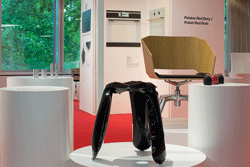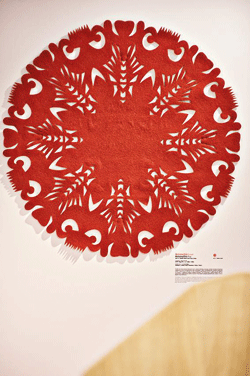
Polish Design: a metamorphosis
By Czesława Frejlich - Professor, Academy of Fine Arts, Krakow and Academy of Fine Arts, Warsaw and editor-in-chief of 2+3D design magazine.
Until recently, Poland was not perceived as a country with a strong design sector. Poles themselves were quick to admit that this was not the strong suit of our economy. A brief look at Poland's post-war history offers some explanation. In the 1950s, the economic focus was on rebuilding our industrial sector with emphasis on heavy industry and mining. Amid efforts to boost the country's consumer products industry in the 1960s, Polish industrial design was reborn. This was, in large part, due to the efforts of the Institute of Industrial Design and the creation of a number of new design schools, but is also attributable to the successes of designers who broke through the "iron curtain ", which had precluded professional contact with designers from the West. This resurgence, however, was short-lived. A lack of competition in the market in the 1970s and the widespread practice of purchasing Western licenses for new technologies, and product models, hampered the work of Polish designers. By the early 1980s, during the Martial Law period in Poland, things had almost come to a complete standstill.

Signs of change
With Poland's transition to democracy after 1989, the country's focus was on learning the ropes of the new economy, primarily in the area of trade. Industrial design was not an immediate priority. The first visible signs of change came about in the early 2000s, with the emergence of a number of large companies that had grown from small family initiatives. These companies were slowly finding their feet in the national market, elbowing out cheap foreign imports.
The introduction of modern technologies and exposure to new management, promotional and sales techniques as a result of subcontracting services for Western companies also made a significant impact on the sector's development. In a relatively short period, we saw the evolution of home-grown furniture companies such as Balma, Vox, Profiem, and Comforty. By 2011, Poland was ranked fourth in the world for furniture exports (according to United Nations statistics for 2011). Companies like Solaris (buses), and Pesa and Newag (the rail industry) and Reserve, House, and Ryłko (clothing) were also competing in international markets with growing confidence.
Growing awareness of the role of design in business
While the dynamic economic growth rates of recent years have slowed as a result of the current global economic crisis, the average is still on the plus side. Producers who have thus far competed with low prices have come to understand that they cannot lower their prices any further and are in search of new ways to secure a competitive advantage. Many have come to understand that design is the most obvious tool for boosting sales and have sought out new designs to call their own.
Until recently, copying a good foreign product (in a slightly altered form to avoid legal difficulties) was regarded as a legitimate and effective commercial strategy. The success of a growing number of well-designed products over the last two years, however, suggests that such an approach is not only considered to be unethical, but is also short-sighted and unprofitable. Growing success in national and international design competitions, such as the international Red Dot Design Award is fuelling international recognition of Polish design. Since 2008, when Polish designers Magda Lubińska and Michał Kopaniszyn of Moho Design were awarded for their mohohej!DIA carpet, Polish companies have won thirty awards, of which twelve in 2012. In May 2013, Polish winners of this prestigious award took pride of place in an exhibition co-organized by the Polish Patent Office at WIPO.

Polish design attracts the spotlight
In recent years, the industrial design sector has benefitted from the active support of the Polish government. It was identified in the national development strategy for 2007 to 2013 as an area qualifying for financial support, mainly through European Union (EU) grants. Such targeted support has served to significantly improve design education, giving rise to design mentoring services and the creation of design centers across the country. These include, the Gdynia Design Center, Concordia Design in Poznań, Design Center Kielce, the Center for the Promotion of Fashion, and the Center of Arts and Sciences in Łódź. Private design schools have also emerged in Kielce, Łódź, Poznań, and Szczecin, among others, and new design study programs have been introduced as part of the curriculum of state schools. Recently acquired EU funds will be used to forge closer university-industry links, including in the area of industrial design.
Government support has also played a key role in encouraging a wide range of promotional activities, including numerous exhibitions, conferences and debates, which are shining the spotlight on Polish design, both at home and abroad. Some activities planned within the national development strategy, however, were not entirely successful. While employers did not receive the financial support to develop or acquire new industrial designs they had hoped for, many found the resources to continue investing in design and are now enjoying the commercial benefits of having done so. In less than 10 years, the number of industrial design applications filed by Polish applicants with the Polish Patent Office and the Office of Harmonization for the Internal Market (OHIM) has more than doubled. In 2003, these offices received 2,002 design applications from Polish designers; in 2012 this figure rose to 4,470 indicating growing recognition of the importance of protecting designs.
The greatest impact in terms of raising the international profile of Polish design has resulted from the widespread promotional activities that are being organized. Within Poland, such events include the Łódź Design Festival in October (in its seventh year), Arena Design in Poznań in March, (in its fifth year) and Gdynia Design Days in July, (in its sixth year). This is in addition to numerous presentations in galleries and commercial shows throughout the year. Abroad, promotion of Polish design mainly falls to the Adam Mickiewicz Institute and the Ministry of Foreign Affairs which work together with the numerous Polish Institutes scattered around the globe, such as those in Berlin, Budapest, London and Stockholm. This year, for example, Polish designers showcased their work at the Milan Design Week and the DMY International Design Festival in Berlin. Participation in other major international design events, such as Paris Design Week and 100% Design at the London Design Festival, are also in the sights of the Polish design community.
Shifting attitudes
In recent years there has been a dramatic shift in attitude to design in Poland. Public and private institutions alike are seeking out opportunities to promote the country's prowess in this field fuelling a groundswell of public support. Until recently, Polish designers were operating in a tough landscape. Their main customers, those willing to pay top prices for high-quality products, had little faith in Polish designers and often sourced their products from abroad. The less wealthy were not inclined to pay more for a new product and tended to buy cheaper items, even if the quality of the design was inferior. Thanks to improved living standards, however, this situation has changed. Research by Tomasz Wiktorski in 2011 on the furniture industry in Poland found that the average Pole is now willing to pay 20 percent more for a better product. This shift can be attributed to the growing aspirations of young people whose exposure to design in other parts of the world via the Internet, study and travel, is driving demand for high quality and well-designed products.
This positive change in attitude towards design is also rekindling interest in the country's design heritage. A growing number of academic and popular titles are emerging on the subject. Auction houses are also recording high prices paid by collectors for legacy designs. The younger generation has come to appreciate earlier designs, especially those dating from the 1960s. These are being unearthed from family attics and reused. This spirit of nostalgia is visible in a number of contemporary designs, as an inspiration or a quotation. In some instances, contemporary designers are giving old designs new life by simply reusing them. The fact that some 35,000 people visited the exhibition entitled We Want to Be Modern: Polish Design from 1955-1968 from the Collections of the National Museum in Warsaw in 2012 is indicative of the scale of public interest in Polish design.
The WIPO Magazine is intended to help broaden public understanding of intellectual property and of WIPO’s work, and is not an official document of WIPO. The designations employed and the presentation of material throughout this publication do not imply the expression of any opinion whatsoever on the part of WIPO concerning the legal status of any country, territory or area or of its authorities, or concerning the delimitation of its frontiers or boundaries. This publication is not intended to reflect the views of the Member States or the WIPO Secretariat. The mention of specific companies or products of manufacturers does not imply that they are endorsed or recommended by WIPO in preference to others of a similar nature that are not mentioned.